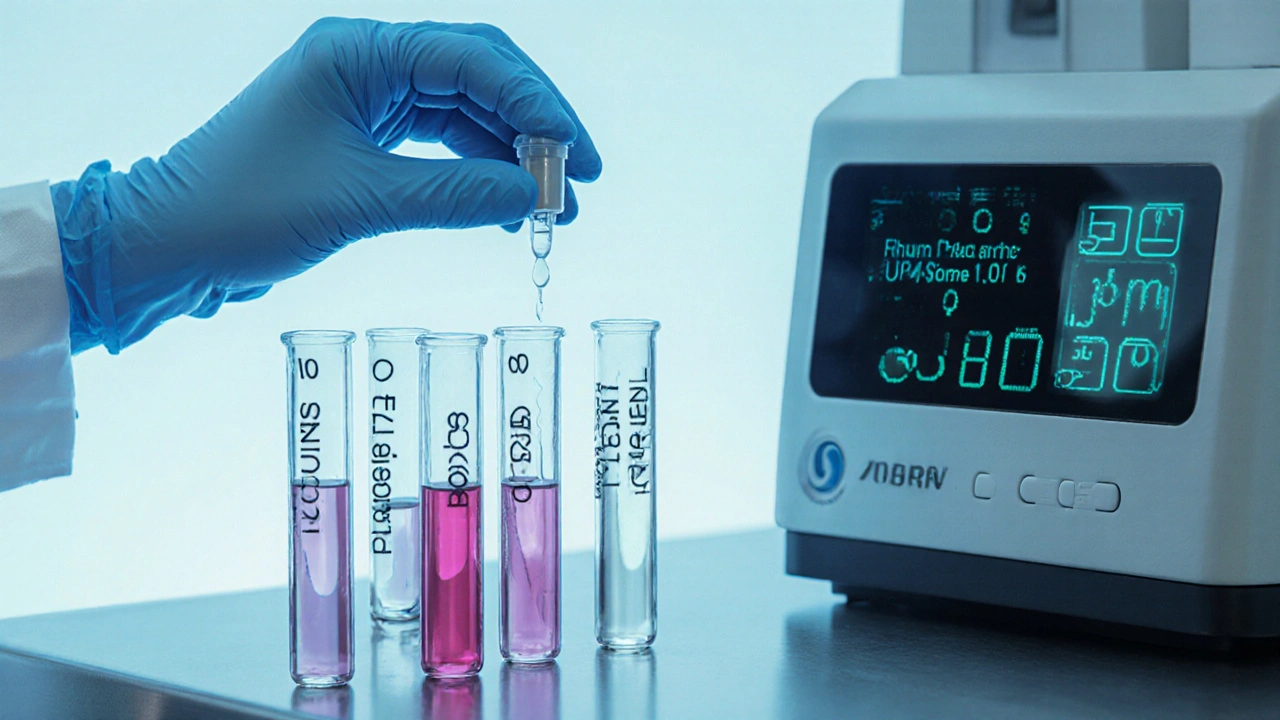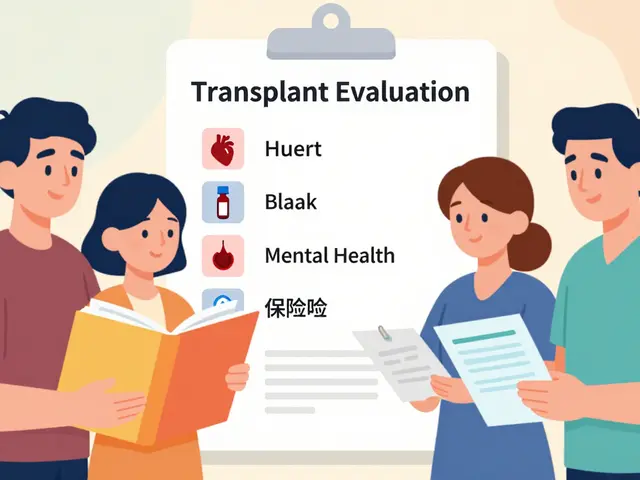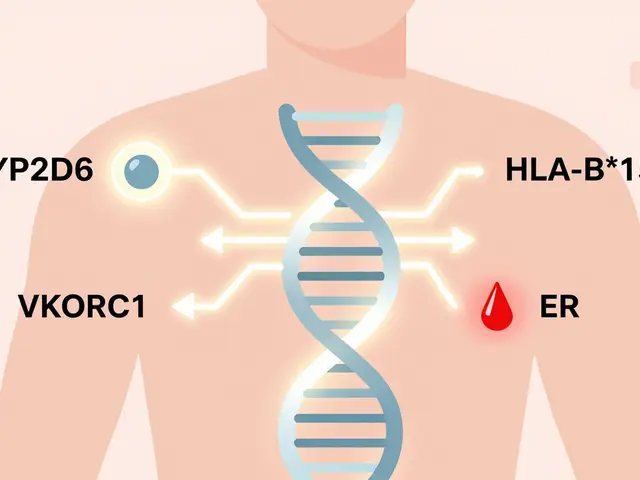
Blood Clotting Test Calculator
Enter test type and value, then click Calculate to see interpretation.
INR: 1.0 (normal)
Therapeutic Range: 2.0-3.0
Platelet Count: 150-400 × 10⁹/L
D-Dimer: < 0.5 mg/L (negative)
Quick Take
- Blood clotting tests check how fast your blood forms clots and spot bleeding disorders.
- Common tests include PT/INR, aPTT, platelet count, and D-dimer.
- Preparation usually means no fasting, but you may need to pause certain meds.
- Samples are drawn from a vein into a citrate tube; the lab does the rest.
- Results come back in a few days and guide treatment decisions.
When your doctor orders blood clotting tests a group of laboratory analyses that assess how quickly your blood forms clots, you might wonder what’s involved, whether you need to fast, and what the numbers really mean. This guide walks you through the most common tests, how they’re collected, how to prepare, and what to expect once the lab finishes its work.
What Are Blood Clotting Tests?
Blood clotting tests, also called coagulation studies, evaluate the complex cascade that turns liquid blood into a solid clot. The cascade includes proteins called clotting factors, platelets, and fibrin strands. Disruptions can cause excessive bleeding or dangerous clots, so doctors use these tests to diagnose conditions like hemophilia, liver disease, or to monitor anticoagulant therapy.
Two major pathways are measured: the extrinsic pathway (triggered by tissue injury) and the intrinsic pathway (activated by blood contacting foreign surfaces). By checking both, clinicians get a full picture of your hemostatic health.
Why Your Doctor Might Order Them
Typical reasons include:
- Evaluating unexplained bruising or bleeding.
- Screening before surgery or dental work.
- Monitoring warfarin or newer oral anticoagulants.
- Investigating liver function, since the liver makes many clotting factors.
- Checking for clot‑forming disorders after a deep‑vein thrombosis (DVT) or pulmonary embolism.
Common Types of Blood Clotting Tests
Below are the most frequently ordered studies, each with a short description.
Prothrombin Time (PT) measures the extrinsic pathway and reports how many seconds it takes for plasma to clot after adding tissue factor. Results are often expressed as an International Normalized Ratio (INR) to standardize across labs.
International Normalized Ratio (INR) is a calculated value that compares your PT to a normal reference and adjusts for reagent differences. Therapeutic INR ranges (usually 2.0‑3.0) guide warfarin dosing.
Activated Partial Thromboplastin Time (aPTT) assesses the intrinsic pathway by measuring clotting time after adding an activator and phospholipid. It’s the go‑to test for monitoring heparin.
Platelet Count counts the number of platelets per microliter of blood; low counts can cause bleeding, high counts can predispose to clots.
D‑dimer Test detects degradation products of fibrin; elevated levels suggest recent clot formation or breakdown. It’s commonly used to rule out DVT or pulmonary embolism.
How the Samples Are Collected
All coagulation tests require a blood sample drawn from a vein, usually the median cubital vein in the arm. The key detail is the use of a citrate tube a purple‑top tube containing sodium citrate that binds calcium and prevents clotting until the lab adds calcium back. This preserves the clotting factors in their native state.
The phlebotomist will clean the site, apply a tourniquet, and insert a needle. After the draw, a small amount of pressure is applied to stop bleeding. The whole process takes about five minutes.

Preparing for Your Appointment
Most clotting tests don’t require fasting, but there are a few important steps to get right:
- Medication Review: Ask your doctor if you should hold any blood thinners (e.g., warfarin, direct oral anticoagulants) or supplements like vitamin K, fish oil, or aspirin. Some labs need a wash‑out period to avoid skewed results.
- Hydration: Drink plenty of water the day before; well‑hydrated veins are easier to access.
- Avoid Heavy Exercise: Strenuous activity can temporarily raise certain clotting factor levels.
- Medical History: Bring a list of recent surgeries, infections, or liver issues, as these can affect outcomes.
- Timing: If you’re on warfarin, many doctors schedule the draw at the same time of day each week for consistency.
In most cases, you can eat normally before the test. However, if a D‑dimer is ordered to rule out a clot, fasting isn’t needed, but if the doctor also orders a lipid panel, you’ll be asked to fast for that portion.
What Happens After the Blood Is Drawn
Once the sample reaches the lab, technicians add calcium chloride to neutralize the citrate, then start the clotting cascade in a controlled environment. Automated coagulometers measure the time it takes for a clot to form and calculate the result.
Modern labs typically report results within 24‑48hours. Critical values (e.g., PT>25seconds) trigger an immediate phone call from the lab to your provider.
Interpreting the Results
Understanding the numbers helps you grasp why a doctor might adjust medication.
- PT/INR: A normal PT is about 11‑13.5seconds; an INR of 1.0 is “normal”. Therapeutic ranges depend on the condition-most patients on warfarin aim for 2.0‑3.0.
- aPTT: Normal range is roughly 25‑35seconds. Prolonged aPTT can mean heparin effect, factor deficiency, or lupus anticoagulant.
- Platelet Count: 150‑400×10⁹/L is typical. Below 100×10⁹/L may cause bleeding; above 450×10⁹/L can increase clot risk.
- D‑dimer: Values <0.5µg/mL FEU are generally considered negative for acute clot. Elevated results need clinical correlation.
Always discuss the findings with your clinician; they’ll consider your overall health, meds, and the reason for testing.
Comparison of the Most Common Coagulation Tests
| Test | Pathway Assessed | Typical Use | Units/Reference | Medication Impact |
|---|---|---|---|---|
| PT/INR | Extrinsic (Factor VII) | Warfarin monitoring, pre‑op screening | Seconds / Ratio | Warfarin ↑, VitaminK ↓ |
| aPTT | Intrinsic (Factors VIII, IX, XI, XII) | Heparin monitoring, factor deficiency work‑up | Seconds | Heparin ↑, Direct oral anticoagulants may affect |
| D‑dimer | Fibrin breakdown | Rule‑out DVT/PE, assess coagulation activation | µg/mL FEU | Usually unaffected; inflammation ↑ |
Tips to Avoid Common Pitfalls
- Double‑check with the lab whether your citrate tube must be filled to a specific volume; under‑filling can falsely prolong PT/INR.
- If you’re on a direct oral anticoagulant (e.g., apixaban), ask whether the test you need is sensitive to that drug-sometimes a special anti‑Xa assay is required.
- Don’t take aspirin or NSAIDs the night before a platelet count if you’re being evaluated for a bleeding disorder; these can temporarily lower platelet function.
- Make sure the phlebotomist releases the tourniquet before drawing the sample; prolonged tourniquet time can concentrate clotting factors.
Frequently Asked Questions
Do I need to fast before a PT/INR test?
No, fasting isn’t required for PT or INR. You can eat and drink normally unless your doctor has ordered another test that does need fasting.
Can I take my blood pressure medication before the test?
Most blood pressure meds don’t interfere with clotting studies, so you can usually keep them. Always confirm with your provider.
What does a high D‑dimer mean?
Elevated D‑dimer indicates recent clot formation or breakdown, but it’s not specific. Infections, inflammation, pregnancy, or recent surgery can also raise it.
Why might my INR be out of range even if I take my warfarin dose correctly?
Dietary vitaminK, herbal supplements, alcohol, or interactions with antibiotics can swing INR up or down. Consistency in timing and dosage is also crucial.
Is a low platelet count always dangerous?
Mildly low counts (e.g., 120×10⁹/L) often cause no symptoms. Trouble usually appears when platelets drop below 50×10⁹/L, leading to easy bruising or bleeding.
Whether you’re preparing for surgery, monitoring a medication, or just checking a lingering bruise, knowing what to expect from blood clotting tests takes the mystery out of the lab visit. Follow the preparation tips, ask the right questions, and you’ll get clear, actionable results that help your doctor keep you safe and healthy.




Lauren Ulm
October 1, 2025 AT 20:44Reading through the clotting guide feels like they’re hiding a secret algorithm behind the INR numbers 🤔. If you think the labs are just neutral, think again – every reagent batch is a potential tool for hidden agendas. The way they say “no fasting” is a gentle nudge to keep us complacent while they collect our data. Remember, the citrate tube isn’t just a plastic container; it’s a Trojan horse for chemistry they don’t want us to question. Stay curious, question the “standard” ranges, and maybe the truth will bleed through. 😎
Michael Mendelson
October 3, 2025 AT 14:24Ah, the naive optimism of the layperson, blissfully trusting the ivory‑towered “standard” without a glimpse of the underlying epistemic abyss. One must appreciate the subtlety of the coagulation cascade, a masterpiece surpassing the pedestrian explanations offered here. To suggest that “most labs report within 24‑48 hours” is a gross understatement, bordering on intellectual laziness. Moreover, the author neglects to mention the socioeconomic stratifications that dictate which reagents are even available – a glaring omission. Such simplifications betray a lack of rigor and a pernicious desire to pacify the masses. Clearly, a deeper dive is warranted, lest we all remain blissfully uninformed.
Ibrahim Lawan
October 5, 2025 AT 08:04Great rundown! It’s helpful to know that most of these tests just need a simple vein draw and no fasting. For anyone on anticoagulants, remember to keep your medication schedule consistent before the lab visit – timing matters. Staying hydrated can make the phlebotomy process smoother, especially if you have small veins. If you have any liver concerns, bring that up with your doctor, as it can influence many of these values. Overall, a solid reference for anyone preparing for a clotting panel.
Just Sarah
October 7, 2025 AT 01:44Indeed, the information presented proves invaluable; however, one must also consider the pre‑analytical variables-such as ambient temperature, tube inversion count, and sample transport time-which can subtly alter coagulation results. Moreover, the clinician’s interpretation should integrate patient‑specific factors, including concurrent medications, dietary vitamin K intake, and underlying comorbidities, to avoid misrepresentation. It is advisable, therefore, to document any recent infections or inflammatory states, as these may transiently affect fibrinogen levels. Finally, ensuring a consistent draw time each week, particularly for warfarin monitoring, enhances longitudinal comparability.
Anthony Cannon
October 8, 2025 AT 19:24Know the basics: no fasting, keep meds steady, and expect results in a couple of days.
Kristie Barnes
October 10, 2025 AT 13:04Totally, just a heads‑up to stay hydrated before the draw.
Zen Avendaño
October 12, 2025 AT 06:44This guide hits the key points, but let’s add that certain herbal supplements-like ginseng or garlic-can skew PT/INR readings, so it’s wise to pause them temporarily. Also, if you’re scheduled for surgery, the lab may request a repeat draw to confirm stable values. For patients on direct oral anticoagulants, the timing of the last dose relative to the blood draw is crucial; often a 12‑hour window is recommended. Don’t forget to ask the lab whether they run the test on a manual or automated coagulometer, as methodology can affect reference ranges. Lastly, keep a copy of your results for future appointments; they’re handy for dose adjustments.
Michelle Guatato
October 14, 2025 AT 00:24Sure, the “herbal supplement” warning is just a smokescreen to keep us from digging deeper into the pharmaceutical lobby’s grip on the healthcare system. They conveniently omit the fact that many of the reagents used in these clotting assays are patented by big biotech firms, who profit from the “standardized” ranges they dictate. The recommendation to repeat draws before surgery? Think of the extra billing, the lab fees, the endless stream of revenue. And that 12‑hour window for direct oral anticoagulants? It aligns perfectly with the manufacturers’ dosing schedules, ensuring their drugs stay in the spotlight. Even the suggestion to keep a copy of your results is a way to create more data points they can later mine for “research”. In short, every line is crafted to keep the system humming and our pockets lighter.
Gabrielle Vézina
October 15, 2025 AT 18:04One might think this article offers a clear path through the murky world of coagulation testing but it merely skims the surface. The author tells us no fasting is needed yet never mentions the impact of hidden dietary factors such as hidden sugars that can alter platelet function. They cite “standard ranges” as if they are immutable truths while ignoring regional laboratory variations that can shift those numbers by a full unit. The claim that “samples are drawn from a vein in five minutes” glosses over the anxiety patients feel when a needle approaches. The mention of citrate tubes is brief, leaving out the chemistry that can be disrupted by improper mixing. The guide suggests hydration helps but fails to address dehydration in elderly patients who may have chronic low blood volume. It also overlooks the role of chronic inflammation in elevating D‑dimer levels independent of clotting events. While the piece lists reasons doctors order these tests, it does not question whether over‑testing has become a habit of modern medicine. The advice to keep medication schedules steady is sound but the article does not warn about over‑the‑counter supplements that silently interfere. The focus on “results within 24‑48 hours” forgets that critical values often trigger a frantic phone call that can cause unnecessary panic. The brief statement that “critical values trigger immediate calls” is a thin veil over the stress placed on patients awaiting that call. The piece does not discuss the psychological burden of waiting for results that may lead to unnecessary lifestyle changes. It also fails to mention insurance implications where certain tests may be denied, leading to costly out‑of‑pocket expenses. The conclusion that “understanding the numbers helps adjust medication” is an oversimplification of a complex decision‑making process. Finally, the article’s tone is reassuring yet it hides the reality that many patients are left confused, anxious, and financially strained by the very tests meant to protect them.
carl wadsworth
October 17, 2025 AT 11:44I hear you – the guide does simplify some nuances, but it still provides a solid starting point for patients. Adding a note about regional lab variations could definitely make it more robust. It’s also true that insurance hurdles can be frustrating; perhaps a tip on checking coverage beforehand would help. Overall, the article’s core information remains valuable for anyone preparing for a clotting panel.
Neeraj Agarwal
October 19, 2025 AT 05:24While the article covers the basics well, it could note that the aPTT reference range may differ between instruments. Also, some labs use photo‑optical detection which can affect the result. A quick reminder to confirm the method with the lab would be useful.
Rose K. Young
October 20, 2025 AT 23:04Honestly this “quick reminder” is just a lazy after‑thought. If you wanted to be thorough you would have mentioned the differences from the start. Most patients don’t care about detection methods – they just want a clear answer. This half‑baked tip feels like an excuse for cutting corners.
Christy Pogue
October 22, 2025 AT 16:44Love how this guide breaks everything down into bite‑size pieces! It’s super helpful to know that you don’t need to fast for most of these tests. Keeping a water bottle handy before the draw makes the whole process way smoother. Thanks for the clear checklist – I feel way more confident heading into my appointment.
Helena Pearson
October 24, 2025 AT 10:24So glad you found it useful 😊! Remember, staying hydrated not only eases the venipuncture but also helps maintain plasma volume for accurate readings. If you’re on any supplements, jot them down – even tiny amounts of vitamin K can sway the INR 🍃. And don’t forget to bring a list of recent surgeries or infections; those details can fine‑tune the doctor’s interpretation. Lastly, a quick post‑draw snack can prevent any faintness – a banana or a granola bar works wonders 🍌. Keep that positive vibe, and good luck with your results! 🎉
Patricia Fallbeck
October 26, 2025 AT 03:04Another “no‑fasting” claim? It’s convenient, sure, but what about those hidden carbs in your morning coffee that could tweak your platelet stability? The article’s tone feels like it’s trying to pacify us, glossing over the messy reality of diet‑lab interactions. Maybe a deeper dive into how everyday beverages affect D‑dimer would be more honest. Still, it’s a decent primer for the uninitiated.
Brett Snyder
October 27, 2025 AT 20:44Honestly this is just typical nonsense – they’ll tell you anything to keep the labs busy. Who even reads the fine print?
Nidhi Jaiswal
October 29, 2025 AT 14:24The guide is simple and clear. It helps to know what to expect before the test.
Sunil Sharma
October 31, 2025 AT 08:04Yes, keeping expectations realistic can reduce anxiety. It’s also good to ask the lab about any special prep they recommend. This way you’re fully prepared and confident.